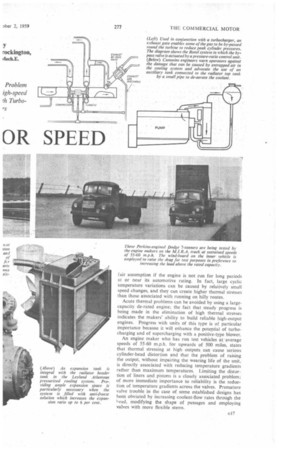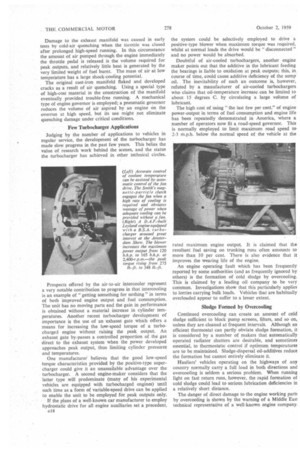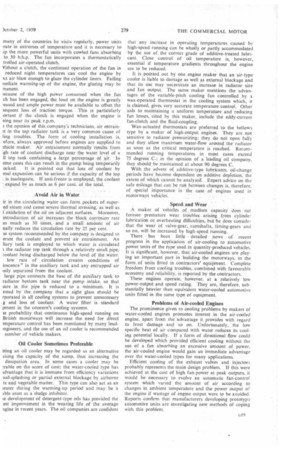Pow'
Page 118

Page 119

Page 120

Page 121

If you've noticed an error in this article please click here to report it so we can fix it.
OR SPEED
Temperature Control th in Designing Engine's Running : Valuable Dev, chargers and Al
MOTORWAY developments in this country have emphasized the preparedness of British engine manufacturers to meet an expected demand for vehicles that will operate continuously at high speeds. Most makers have exported large numbers of engines in
their own chassis, or as proprietary units, to countries having a network of highways on which vehicle speed can be maintained at, or near, its maximum for long distances.
British units have earned an enviable reputation for reliability and :economy in the export market, and this has given their makers A justifiable confidence that they can cater for more exacting speed requirements at home or overseas in face of intense competition.
The increasing influence of the European Common Market and the high speeds to be expected on the motor ways will provide a challenge to engine makers, but the problems for them are relatively straightforward compared with those facing the chassis designers. The features of an engine are decided by the need to cater for a range of requirements common to many countries; the ideal chassis layout in a particular area is, however, largely dictated by the lbcal " construction-and-use " regulations.
The most interesting aspects of advances in engines inevitably relate to detail. Investigations into research work in this country reveal that British makers are tackling the problems associated with sustained high speed with realistic regard to detailed improvements that offer basic gains in reliability as well as improved performance.
When references are made in this review to faults revealed by high-speed tests, they indicate shortcomings resulting from overload running which would not develop if the engine had been operating well within its rated capacity. Their elimination, therefore, represents measures that have been taken to widen the scope of the unit or to evolve the basis of a new prototype.
The majority of recommendations for increasing the road-speed capacity of engines, advanced by engine manu facturers, oil company technicians and consultants, relate to some aspect of temperature control. The need to provide accurate regulation of water and lubricant temperatures, for example, is emphasized by a number of authorities. One engine maker describes cyclic temperature changes as the most difficult problem facing oil engine designers.
Speed uniformity over long distances and the infrequent use of gearboxes and brakes are cited by the majority of vehicle makers as factors that are favourable to engine wear rates and reliability. This undoubtedly represents a 616 fair assumption if the engine is not run for long periods at or near its automotive rating. In fact, large cyclic temperature variations can be caused by relatively small speed changes, and they can create higher thermal stresses than those associated with running on hilly routes.
Acute thermal problems can be avoided by using a largecapacity de-rated engine; the fact that steady progress is being made in the elimination of high thermal stresses indicates the makers' ability to build reliable high-output engines. Progress with units of this type is of particular importance because it will enhance the potential of turbocharging and of supercharging with a positive-type blower_ An engine maker who has run test vehicles at average speeds of 55-60 m.p.h. for upwards of 500 miles, states that thermal stressing at high outputs can cause serious cylinder-head distortion and that the problem of raising the output, without impairing the wearing life of the unit, is directly associated with reducing temperature gradients rather than maximum temperatures. Limiting the distortion of liners and pistons is a closely associated problem: of more immediate importance to reliability is the reduction of temperature gradients across the valves. Premature valve trouble in the case of some established designs has been obviated by increasing coolant-flow rates through the head, modifying the shape of passages and employing valves with more flexible stems. Damage to the exhaust manifold was caused in early tests by cold-air quenching when the throttle was closed after prolonged high-speed running. In this circumstance the amount of air pumped through the engine immediately the throttle pedal is released is the volume required for peak outputs, and relatively little heat is generated by the very limited weight of fuel burnt. The mass of air at low temperature has a large shock-cooling potential. The original cast-iron manifold flaked and developed cracks as a result of air quenching. Using a special type of high-cost material in the construction of the manifold eventually provided trouble-free running. A mechanical type of engine governor is employed; a pneumatic governor reduces the volume of air aspired by an engine on the overrun at high speed, but its use might not eliminate quenching damage under critical conditions.
Few Turbocharger Applications
Judging by the number of applications to vehicles in regular service, the development of the turbocharger has made slow progress in the past few years. This belies the value of research work behind the scenes, and the status the turbocharger has achieved in other technical circles.
Prospects offered by the air-to-air intercooler represent a very notable contribution to progress in that intercooling is an example of "getting something for nothing" in terms of both improved engine output and fuel consumption. The unit has no moving parts and the gain in performance is obtained without a material increase in cylinder temperatures. Another recent turbocharger development of importance is the use of an exhaust gate which offers a means for increasing the low-speed torque of a turbocharged engine without raising the peak output. An exhaust gate by-passes a controlled proportion of the gas direct to the exhaust system when the power developed approaches peak output, thus limiting cylinder pressures and temperatures.
One manufacturer believes that the good low-speed torque characteristics provided by the positive-type supercharger could give it an unassailable advantage over the turbocharger. A second engine-maker considers that the latter type will predominate (many of his experimental vehicles are equipped with turbocharged engines) until such time as a form of variable-speed drive can be applied to enable the unit to be employed for peak outputs only.
If the plans of a well-known car manufacturer to employ hydrostatic drive for all engine auxiliaries set a precedent, I 8 the system could be selectively employed to drive a positive-type blower when maximum torque was required, whilst at normal loads the drive would be " disconnected " and no power would be absorbed.
Doubtful of air-cooled turbochargers, another engine maker points out that the additive in the lubricant feeding the bearings is liable to oxidation at peak outputs; this, in course of time, could cause additive deficiency of the sump oil. The inevitability of such an outcome is, however, refuted by a manufacturer of air-cooled turbochargers who claims that oil-temperature increase, can be limited to about 15 degrees C. by circulating a large volume of lubricant.
The high cost of using "the last few per cent." of engine power-output in terms of fuel consumption and engine life has been repeatedly demonstrated in America, where a number of operators now fit a road-speed governor. This is normally employed to limit maximum road speed to 2-3 m.p.h. below the normal speed of the vehicle at the rated maximum engine output. It is claimed that the resultant fuel saving on trunking runs often amounts to more than 10 per cent. There is also evidence that it improves the wearing life of the engine.
An engine operating fault which has been frequently reported by some authorities (and as frequently ignored by others) is the formation of cold sludge by overcooling. This is claimed by a leading oil company to be very common. Investigations show that this particularly applies to lorries carrying bulk loads. Vehicles that are habitually overloaded appear to suffer to a lesser extent.
Sludge Formed by Overcooling
Continued overcooling can create an amount of cold sludge sufficient to block pump screens, filters, and so on, unless they are cleaned at frequent intervals. Although an efficient thermostat can partly obviate sludge formation, it is considered by a number of makers that automatically operated radiator shutters are desirable, and sometimes essential, to thermostatic control if optimum temperatures are to be maintained. Sludge-dispersal oil-additives reduce the formation but cannot entirely eliminate it.
Hauliers' vehicles operating on the highways of any country normally carry a full load in both directions and overcooling is seldom a serious problem. When running light on fast return runs, however, the rapid formation of cold sludge could lead to serious lubrication deficiencies in a relatively short distance.
The danger of direct damage to the engine working part2 by overcooling is shown by the warning of a Middle Easi technical representative of a well-known engine company. many of the countries he visits regularly, power units irate in extremes of temperature and it is necessary to iip the more powerful units with cowled fans absorbing to 30 b.h.p. The fan incorporates a thermostatically trolled air-operated clutch.
Vithout a clutch, the continued operation of the fan in reduced night temperatures can cool the engine by !ct air blast enough to glaze the cylinder liners. Failing nediate warming-up of the engine, the glazing may be manent.
:ecause of the high power consumed when the fan ch has been engaged, the load on the engine is greatly -eased and ample power must be available to offset the sequcnt loss of traction torque. This is particularly iortant if the clutch is engaged when the engine is ning near its peak r.p.m.
the opinion of this company's technicians, air entrainit in the top radiator tank is a very common cause of ling troubles. The form of cooling installation is, .efore, always approved before engines are supplied to l'hicle maker. Air entrainment normally results from igh rate of coolant discharge near the water level of a 11 top tank containing a large percentage of air. In eme cases this can result in the pump being temporarily ocked. It is pointed out that loss of coolant by mal expansion can be serious if the capacity of the top . is inadequate. If anti-freeze is employed; the coolant r expand by as much as 6 per cent. of the total.
Avoid Air in Water it in the circulating water can form pockets of supered steam and cause severe thermal stressing, as well as 1 oxidation of the oil on adjacent surfaces. Moreover, introduction of air increases the block corrosion rate as much as 30 times, and a small amount of air nally reduces the circulation rate by 25 per cent.
se system recommended by the company is designed to crate the coolant and prevent air entrainment. An liary tank is employed to which water is circulated the radiator top tank through a relatively small pipe. :oolant being discharged below the level of the water, low rate of circulation creates conditions of iescence" in the auxiliary tank and any entrapped air tsily separated from the coolant.
large pipe connects the base of the auxiliary tank to radiator bottom tank near the pump intake, so that sure in the pipe is reduced to a minimum. It is ested by the company that a sight glass should be rporated in all cooling systems to prevent unnecessary g and loss of coolant. A water filter is standard pment in the concern's cooling systems.
le probability that continuous high-speed running on British motorways will increase the need for direct !mperature control has been mentioned by many leadmgineers, and the use of an oil cooler is recommended number of vehicle makers.
Oil Cooler Sometimes Preferable
tting an oil cooler may be regarded as an alternative using the capacity of the sump, thus increasing the dissipation area. In some cases a cooler may be rable on the score of cost; the water-cooled type has idvantage that it is immune from efficiency variations iud-splashing or partial external blockage by airborne ts.and vegetable matter. This type can also act as an water during the warming-up period and may be a ible asset as a sludge inhibitor.
Le development of detergent-type oils has provided the :est improvement in the wearing life of the average agine in recent years. The oil companies are confident that any increase in operating temperatures caused by high-speed running can be wholly or partly accommodated by the use of the correct grade of additive-treated lubricant. Close control of oil temperature is, however, essential if temperature gradients throughout the engine are to be reduced.
It is pointed out by one engine maker that an air-type cooler is liable to damage as well as external blockage and that its use may necessitate an increase in radiator size and fan output. The same maker mentions the advantages of the variable-pitch cooling fan controlled by a wax-operated thermostat in the cooling system which, it is claimed, gives very accurate temperature control. Other aids to maintaining a uniform temperature and reducing fan losses, cited by this maker, include the eddy-current fan-clutch and the fluid-coupling.
Wax-actuated thermostats are preferred to the bellows type by a maker of high-output engines. They are not sensitive to radiator pressurizing; they do not open fully and they allow maximum water-flow around the radiator as soon as the critical temperature is reached. Recommended running temperatures in most cases exceed 75 degrees C.; in the opinion of a leading oil company. they should be maintained at about 90 degrees C.
With the advent of additive-type lubricants, oil-change periods have become dependent on additive depletion, the extent of which cannot be analysed. Expert advice on the safe mileage that can be run between changes is, therefore, of special importance in the case of engines used in motorways vehicles.
Speed and Wear
A maker of vehicles of medium capacity does not foresee premature wear troubles arising from cylinder lubrication or overheating difficulties, but he does con side: that the wear of valve-gear camshafts, timing-gears and so on, will be increased by high-speed running.
There has been little detailed news of recent progress in the application of air-cooling to automotive power units of the type used in quantity-produced vehicles. It is significant, however, that air-cooled engines are playing an important part in building the motorways, in the form of units fitted in contractors' equipment. Complete freedom from cooling troubles, combined with favourable economy and reliability, is reported by the contractors.
These engines operate, however, at a relatively low power-output and. speed rating. They are, therefore, substantially heavier than equivalent water-cooled automotive units fitted in the same type of equipment.
Problems of Air-cooled Engines The prominence given to cooling problems by makers of water-cooled engines promotes interest in the air-cooled engine, apart from the advantage it provides with regard to frost damage and so on. Unfortunately, the low specific heat of air compared with water reduces its cooling potential locally. If a form of directional flow could be developed which provided efficient cooling without the use of a fan absorbing an excessive amount of power. the air-cooled engine would gain an immediate advantage over the water-cooled types for many applications.
Efficient cooling of the exhaust valves and injectors probably represents the main design problem. If this were achieved at the cost of high fan-power at peak outputs, it would be necessary to evolve an automatic fan-control system which varied the amount of air according to changes in ambient temperature and the power output of the engine if wastage of engine output were to be avoided. Reports confirm that manufacturers developing prototypc automotive units are investigating new methods of coping with this problem.












































































































































































































































